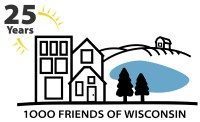
By Steve Hiniker, former Executive Director, 1000 Friends of Wisconsin
Face it. We have a driving problem, and it’s killing us.
We are addicted to driving, and we are in denial about it. We lash out at those who bring it to our attention and label them as “anti-car.” Unfortunately, that is about as constructive as labeling a doctor as “anti-food” if that doctor recommends a diet.
The signs of autobesity are everywhere. If miles were calories, we would be in intensive care. Last year, Wisconsinites racked up an unbelievable 60 billion miles behind the wheel. Each one of us drove, on average, twice as many miles as drivers 25 years ago. We spend, on average, $7,000 a year per car on our addiction – plus parking costs.
Our driving addiction is costing us lives, dollars and destroyed communities every day. In Wisconsin, there is a motor vehicle crash once every five minutes, an injury every 14 minutes and a fatality every 11 hours. We use euphemisms to rationalize the horrible side effects of driving. Though we refer to car crashes as “accidents,” almost all car crashes are avoidable events.
Like most addictions, we are often oblivious to the consequences our habit has on others. Motor vehicles are the principal cause of ozone air pollution and contribute to about one-third of our global warming gas emissions. Highways have destroyed vibrant neighborhoods throughout the state, and more neighborhoods are at risk because of expansion plans. Farmland, wetlands and cultural resources are all-too-frequent victims of road expansion.
Our fixation with driving leads us to build new housing, shopping centers and job centers that are entirely auto-dependent. It is no longer an option to have a car in the typical new development in Wisconsin; it is a requirement.
Unfortunately, those who still walk face increasing obstacles. No sidewalks mean pedestrians must risk sharing the street with cars to reach any destination. Pedestrians often become simply another obstacle for drivers.
As we lose pedestrians, we lose the human connections that make safe and healthy neighborhoods. We lose our identity, and our communities become merely a collection of buildings connected by roads.
So if autobesity is killing us, what can we do about it?
Like eating, driving is necessary. And like eating, driving can be fun. And like eating habits, we can develop healthy driving habits. Recognizing that cars can be an obsession doesn’t mean that cars are bad – nor do we need to take the fun out of driving. Just as we like good food, we can enjoy nice cars. We just need to know when to say “enough.”
We need to stop investing in developments that require driving. The proposed $25 million interchange to feed cars into a proposed mall at Pabst Farms is a good example of auto-dependent development that should not be subsidized by state taxpayers. The mall will stand like a chocolate fudge cake with sour cream frosting for the autobesity crowd.
We should invest in healthy alternatives that don’t require a driver’s license for admission. Transit-oriented development can accommodate auto traffic while allowing and encouraging access by pedestrians and transit users.
Oconomowoc would be better served by re-establishing rail service to Milwaukee and Madison. New retail could be incorporated with downtown plans accommodating cars as well as shoppers and workers arriving by train service. We also would have fewer cars clogging up the interstate and spilling over to local streets.
The choice is clear: Feed autobesity with the junk food diet of ever-expanding highways or start a new healthy multimodal diet that recognizes the necessity of driving but also promotes healthy communities by investing in transit, walking and bicycling.
